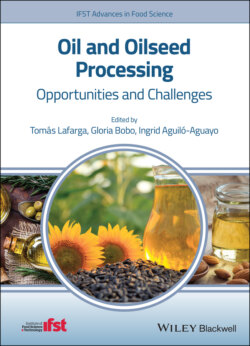Читать книгу Oil and Oilseed Processing - Ingrid Aguilo-Aguayo - Страница 31
2.1 Introduction
ОглавлениеAccording to the FAO Commodity Snapshot (OECD‐FAO 2017) global soybean production increased in the United States and Brazil in 2016 registering record crops. Soybean is one of the most important duel‐purpose crops with a different use in food, animal feed, biochemistry, and industrial purposes (Pratap et al. 2016). Other important conventional oilseed crops include rapeseed, canola, sunflower, safflower, peanut, cottonseed, linseed, and sesame. The predictions for 2026 are an overall increase of 90% of world soybean production and 86% of world production of other oilseeds due to direct food consumption (OECD‐FAO 2017). Crushing oilseeds into meal (cake) and oil are the main usage. However, the raw materials act as a renewable source of energy and their role in power generation make them a powerful material for oleo‐chemical industries (Jankowski and Budzyński 2003). Therefore, the biofuel industry is one of the applications of these conventional oilseed crops as an alternative to petrochemicals leading the biochemical industries to produce genetically modified oilseed crops to produce high amounts of biofuel (Moser et al. 2013; Waseem et al. 2017).
Focusing on the nutritional properties of oilseed crops, their high amounts of proteins present in the meal fraction obtained after oil removal is a high‐value product for animal feed (Mailer 2016). On the other hand, the increasing demand for healthy vegetable oils has increased the production of oilseed oils use as a commodity due to the presence of polyunsaturated fatty acids and their positive contribution to health due to their antioxidant properties (Intelligence 2006). Polyunsaturated fatty acids in vegetable oils are of importance in human diets. The major polyunsaturated fatty acids include omega‐3, omega‐6 and linoleic acid (Balbino 2017). However, the fatty acid composition will strongly depend on the cultivar, climate, and agronomic conditions as well as the maturity of the oilseeds (Panda 2010). In this context, these oilseed oils represent an alternative to palm oil, which is under discussion due to the high level of saturated fatty acids. High oleic sunflower and high oleic rapeseed oil are considering good solutions (Hinrichsen 2016). However, palm oil is still the most worldwide consumed vegetable oil with 74.62 million metric tons (MT) followed by soybean oil with 56.84 MT and sunflower seed oil with 19.06 MT as recorded in Shahbandeh (2020).
